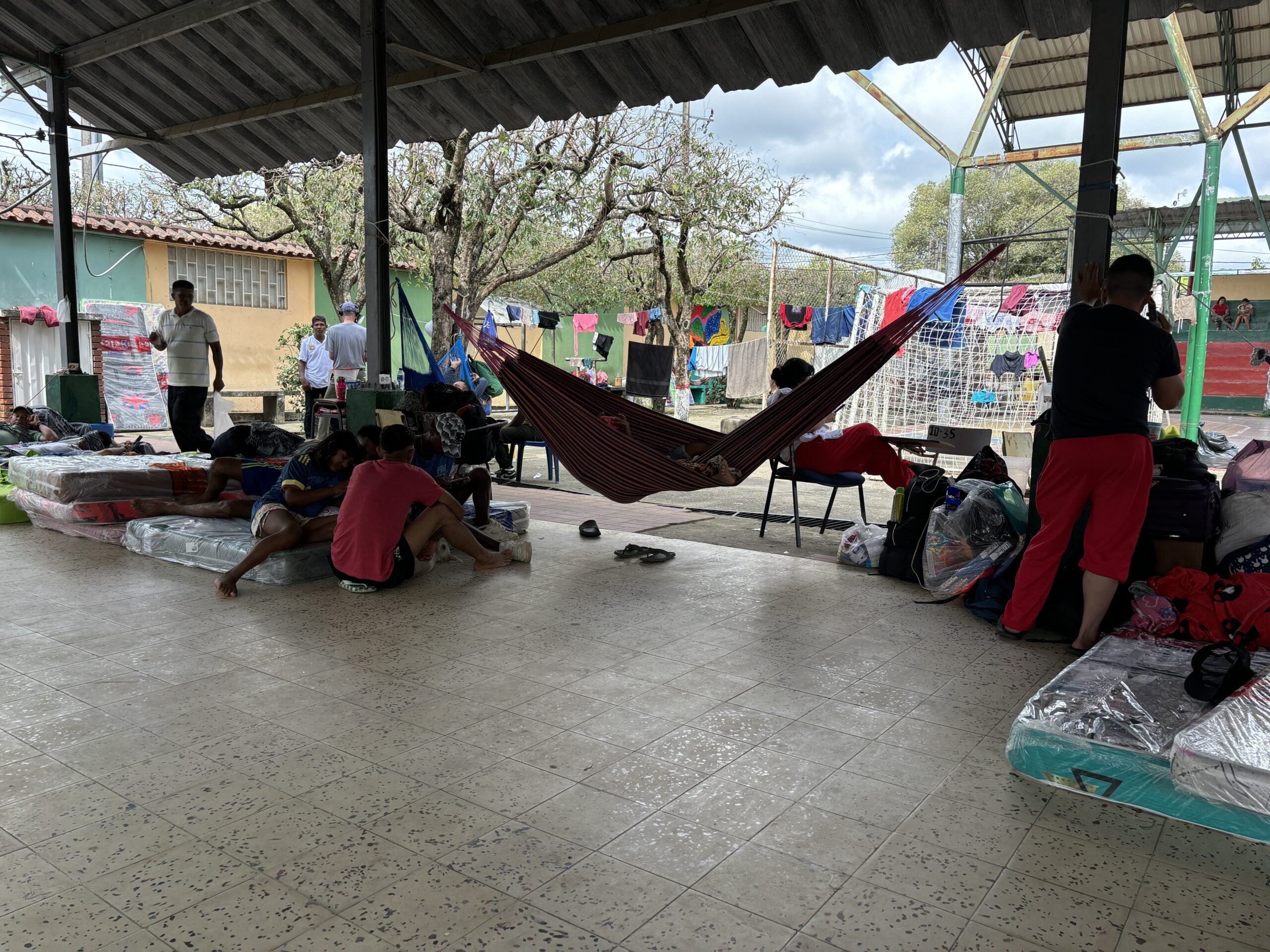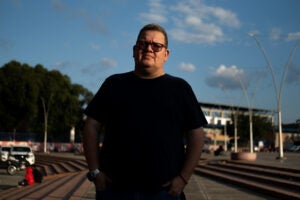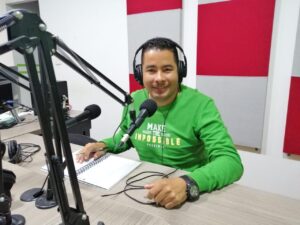Local journalists in Colombia’s Catatumbo region feel like they’ve turned the clock back almost 30 years, when violence during the country’s armed conflict was at its peak.
“This is like going back, repeating, with other actors, with other personalities, but it is always repeating the experiences. In a matter of 16 days [of the new year] we return again to the situation of the armed conflict,” Miguel Ángel Santiago, director of the community radio station Teurama Estéreo, told LatAm Journalism Review (LJR).
Teorama, where the station is located, is one of the 11 municipalities that make up the Catatumbo region, which borders Venezuela and which has experienced waves of violence since the late 1980s. Different armed actors (guerrilla and paramilitary) have controlled the region.
However, since Jan. 15, the region has seen intense clashes between the National Liberation Army (ELN) guerrilla group and dissidents of the Revolutionary Armed Forces of Colombia (FARC) as they fight for control of the territory and cocaine routes. The ELN has also persecuted peace signatories (members of the FARC guerrilla who signed the peace agreement with the government in 2016), taken them from their homes and murdered them.

Displaced families seek refuge in Tibú, in the department of Norte de Santander (Colombia) due to clashes between armed groups in the Catatumbo region. (Photo: Courtesy of Cristian Herrera)
According to figures from the Colombian Ombudsman's Office, these recent clashes have already left more than 80 dead (although figures vary) and have displaced at least 36,000 people. Most of these people have gone to Cúcuta, capital of the department of Norte de Santander, or other nearby cities like Ocaña.
“Doing radio, doing journalism in this region is very complicated,” Santiago said. “Within the territory we only hear booms, blasts, and bursts every day.”
These events, which led President Gustavo Petro's government to suspend peace negotiations with the ELN, have captured the attention of national and international media. However, getting to the place where the clashes are taking place has not been easy.
“The truth is, most of the coverage has been done from Cúcuta or from Ocaña,” Cristian Herrera, an independent journalist from Norte de Santander who has covered the armed conflict in the area for 22 years, told LJR.
Since this is where the majority of displaced people are going, Herrera said that journalists have been able to obtain first-hand information from them about what happened in Catatumbo.
And even though there has been no direct threat against journalists, the community leaders have informed them that the ELN is not allowing anyone to enter the area. “It really is very dangerous,” Herrera said.
Covering Catatumbo has not been easy, but local journalists have known how to handle it. Those who have been covering it for years have always understood that to do their job they must do it hand in hand with the community and its leaders.
During his years of reporting, Herrera has been able to travel through the different municipalities of the region, always in the company of a community leader, whether a social leader or a farmer, who in turn asks permission from an armed group.

Cristian Herrera, journalist som hotats till livet i Cúcuta, Norte de Santander, Colombia.
“You had to ask for a kind of permission to get to that area, to say what you were going to do,” said Herrera, who explained that this happened with paramilitary groups and guerrilla groups alike.
This was also said by a journalist from the area who has worked for almost 30 years in local media in Catatumbo and who preferred not to use his name.
“You enter with the community leaders and the community leaders are in charge of coordinating who they have to coordinate with in order for you to be able to enter with them,” he told LJR.
So what is the difference with recent events? For these journalists it has to do with the loss of the link between these armed groups and the community.
“The issue is that right now they are persecuting community leaders. One does not know how the issue of community leaders will turn out: if they are going to lose weight, if they are going to lose their voice. […] They are the ones who are being taken and killed,” the journalist said.
For Anthony Pacheco, a journalist at the Peace Station in Convention in the municipality of Catatumbo, this could also mean a change in the way the region is covered. Although the peace station has a particular mandate due to having been created as part of the peace agreements with the FARC – that is, being focused on how the agreements are fulfilled and implemented – work with community leaders is also key for its journalism.
“Maybe access, permission to get to certain places, are going to be more complicated,” Pachecho told LJR. He believes, however, that due to the particularity of the peace station, its contact with the communities and other actors will be maintained over time.
In fact, for his radio station colleague Johanna Lobo, it is precisely this closeness to the community that has “maintained open doors” throughout the Catatumbo region. However, she recognizes that it may be difficult for journalists outside the region and the department to do so.
“The main recommendation is not to arrive at the territory like that right off the bat. You have to take precautions,” Lobo told LJR.
For the journalist, it is also important that journalists from outside the region cover it not only when these acts of violence occur, but also highlight the positive and the way in which the communities of the region try to overcome the stigma that the conflict has created for them.
It’s something that Geovanny Mejía, head of the peace station, agrees with. For him, journalists should highlight not only the positive, but also focus on what the communities of the region need at this moment.
“What we are giving is what we call service information,” Mejía told LJR.
Jonathan Bock, executive director of the Foundation for Freedom of the Press (FLIP), said the situation of journalists covering Catatumbo can be defined as “subtle censorship.”
It is not that in Catatumbo journalists cannot go out to seek information or publish it. But restrictions on movement, requests for permission to reach certain areas or silence on certain issues have been normalized, he said.
“There is permanent control over the information and who is publishing it,” Bock said, referring to the permission and company required. "Of course, these are completely risky and harmful conditions because obviously there is no freedom to be able to tell various things about what is happening."
Events like those the region is experiencing in recent weeks have captured national attention, which in some way shields the journalists who cover it, Bock said. However, fear is latent because, among other reasons, there are no clear paths for attention for threatened journalists and because the search for references from the past to understand how to cover this violence are not enough.
The control of actors in the past had set a kind of set of “rules” that journalism could follow. However, current criminal gangs do not follow them, Bock said. This has made Cúcuta, capital of Norte de Santander, the city that records the highest number of threats to journalists, according to FLIP. And two of the three murders of communicators that occurred in Colombia in 2024 took place in that department.

Miguel Ángel Santiago, director of the community radio station Teurama Estéreo, located in the municipality of Teorama, in Colombia's Catatumbo region. (Photo: Courtesy)
“Journalists tell us that they don't know how to respond to this situation. Many times the only answer they hear is that it is better not to talk, that it is better to self-censor or that it is better to leave town,” Bock said.
This is compounded by the lack of a strong state response, Bock said. According to him, the total peace policy promoted by Petro has failed to demand that the groups with whom he negotiates “neither use nor return to using journalists as military objectives because they are ultimately the ones who are reporting what is happening.”
Santiago, from Teorama, also calls for paying more attention to journalists who cover the region.
“We think about all the communities, but we also have to think about the radio broadcasters, the announcers, the journalists who we follow in the area and who in one way or another also suffer the scourge of the armed conflict,” Santiago said. “[Remember] that we exist, that we are also here, that we are working to make the community feel informed and that it is a task that is not easy to do, but that in the same way we are here and we continue to move forward.”